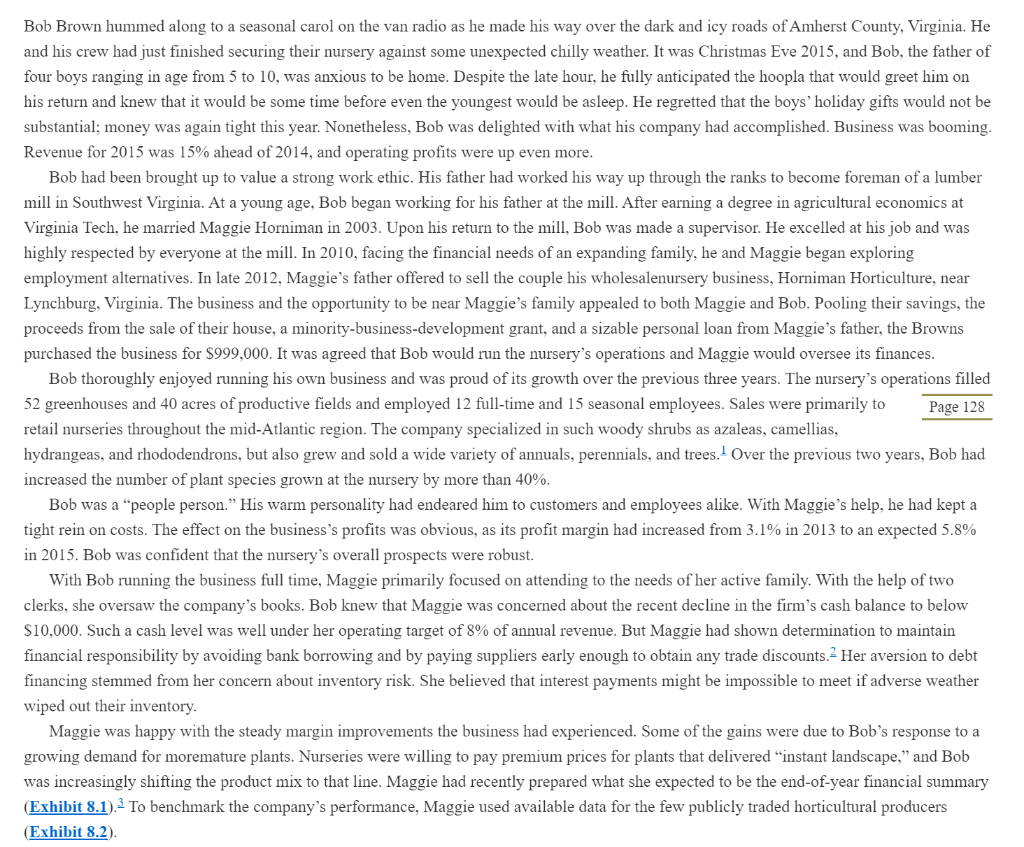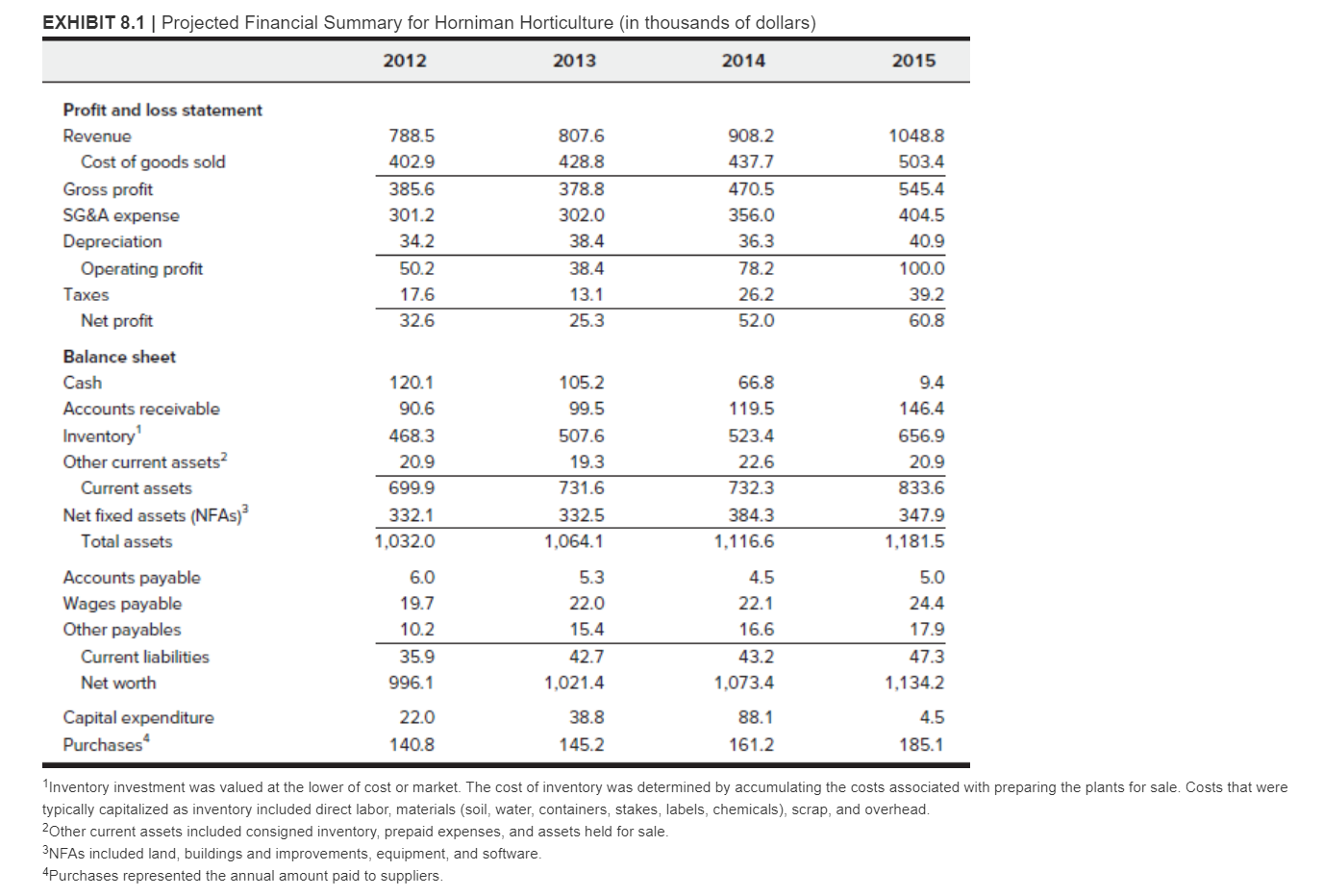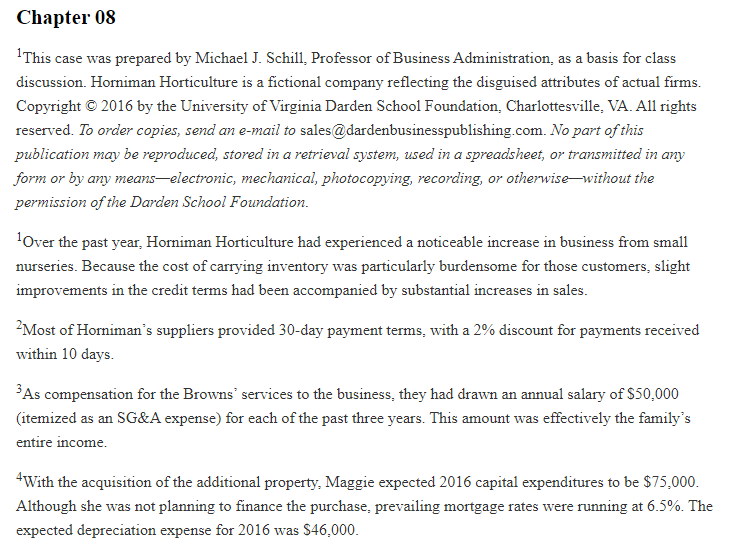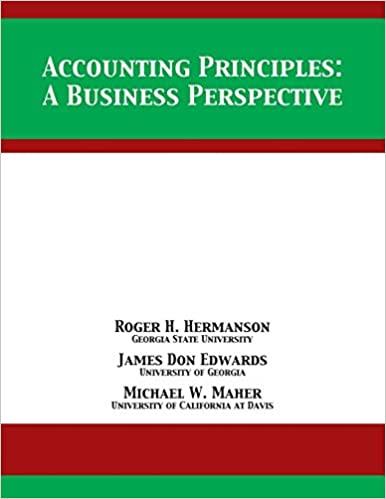Answered step by step
Verified Expert Solution
Question
1 Approved Answer
Could you help figure out why the cash balance was dropping in 2014 and 2015 based on the other numbers? thanks! This is all the





Could you help figure out why the cash balance was dropping in 2014 and 2015 based on the other numbers? thanks!
This is all the info I am given for this
Bob Brown hummed along to a seasonal carol on the van radio as he made his way over the dark and icy roads of Amherst County, Virginia. He and his crew had just finished securing their nursery against some unexpected chilly weather. It was Christmas Eve 2015, and Bob, the father of four boys ranging in age from 5 to 10, was anxious to be home. Despite the late hour, he fully anticipated the hoopla that would greet him on his return and knew that it would be some time before even the youngest would be asleep. He regretted that the boys' holiday gifts would not be substantial; money was again tight this year. Nonetheless, Bob was delighted with what his company had accomplished. Business was booming. Revenue for 2015 was 15% ahead of 2014, and operating profits were up even more. Bob had been brought up to value a strong work ethic. His father had worked his way up through the ranks to become foreman of a lumber mill in Southwest Virginia. At a young age, Bob began working for his father at the mill. After earning a degree in agricultural economics at Virginia Tech, he married Maggie Horniman in 2003. Upon his return to the mill, Bob was made a supervisor. He excelled at his job and was highly respected by everyone at the mill. In 2010, facing the financial needs of an expanding family, he and Maggie began exploring employment alternatives. In late 2012, Maggie's father offered to sell the couple his wholesalenursery business, Horniman Horticulture, near Lynchburg, Virginia. The business and the opportunity to be near Maggie's family appealed to both Maggie and Bob. Pooling their savings, the proceeds from the sale of their house, a minority-business development grant, and a sizable personal loan from Maggie's father, the Browns purchased the business for $999,000. It was agreed that Bob would run the nursery's operations and Maggie would oversee its finances. Bob thoroughly enjoyed running his own business and was proud of its growth over the previous three years. The nursery's operations filled 52 greenhouses and 40 acres of productive fields and employed 12 full-time and 15 seasonal employees. Sales were primarily to Page 128 retail nurseries throughout the mid-Atlantic region. The company specialized in such woody shrubs as azaleas, camellias, hydrangeas, and rhododendrons, but also grew and sold a wide variety of annuals, perennials, and trees. Over the previous two years, Bob had increased the number of plant species grown at the nursery by more than 40%. Bob was a people person. His warm personality had endeared him to customers and employees alike. With Maggie's help, he had kept a tight rein on costs. The effect on the business's profits was obvious, as its profit margin had increased from 3.1% in 2013 to an expected 5.8% in 2015. Bob was confident that the nursery's overall prospects were robust. With Bob running the business full time, Maggie primarily focused on attending to the needs of her active family. With the help of two clerks, she oversaw the company's books. Bob knew that Maggie was concerned about the recent decline in the firm's cash balance to below $10,000. Such a cash level was well under her operating target of 8% of annual revenue. But Maggie had shown determination to maintain financial responsibility by avoiding bank borrowing and by paying suppliers early enough to obtain any trade discounts. Her aversion to debt financing stemmed from her concern about inventory risk. She believed that interest payments might be impossible to meet if adverse weather wiped out their inventory. Maggie was happy with the steady margin improvements the business had experienced. Some of the gains were due to Bob's response to a growing demand for moremature plants. Nurseries were willing pay premium prices for plants that delivered "instant landscape," and Bob was increasingly shifting the product mix to that line. Maggie had recently prepared what she expected to be the end-of-year financial summary (Exhibit 8.1). To benchmark the company's performance, Maggie used available data for the few publicly traded horticultural producers (Exhibit 8.2) EXHIBIT 8.2 | Financial Ratio Analysis and Benchmarking 2012 2013 2014 2015 Benchmark Revenue growth Gross margin (gross profit/revenue) Operating margin (op.profit/revenue) Net profit margin (net profit/revenue) Return on assets (net profit/total assets) Return on capital (net profit/total capital) Receivable days (AR/revenue x 365) Inventory days (inventory/COGS x 365) Payable days (AP/purchases x 365) NFA turnover (revenue/NFA) 2.9% 48.9% 6.4% 4.1% 3.2% 3.3% 41.9 424.2 15.6 2.4 2.4% 46.9% 4.8% 3.1% 2.4% 2.5% 45.0 432.1 13.3 2.4 12.5% 51.8% 8.6% 5.7% 4.7% 4.8% 48.0 436.5 10.2 2.4 15.5% 52.0% 9.5% 5.8% 5.1% 5.4% 50.9 476.3 9.9 3.0 (1.8)% 48.9% 7.6% 2.8% 2.9% 4.0% 21.8 386.3 26.9 2.7 "Benchmark figures were based on 2014 financial ratios of publicly traded horticultural producers. Across almost any dimension of profitability and growth, Bob and Maggie agreed that the business appeared to be strong. They also knew that expectations could change quickly. Increases in interest rates, for example, could substantially slow market demand. The company's margins relied heavily on the hourly wage rate of $10.32, currently required for H2A-certified nonimmigrant foreign agricultural workers. There was some debate within the U.S. Congress about the merits of raising this rate. Bob was optimistic about the coming year. Given the ongoing strength of the local economy, he expected to have plenty of demand to continue to grow the business. Because much of the inventory took two to five years to mature sufficiently to sell, his top-line Page 129 expansion efforts had been in the works for some time. Bob was sure that 2016 would be a banner year, with expected revenue hitting a record 30% growth rate. In addition, he looked forward to ensuring long-term-growth opportunities with the expected closing next month on a neighboring 12-acre parcel of farmland. But for now, it was Christmas Eve, and Bob was looking forward to taking off work for the entire week. He would enjoy spending time with Maggie and the boys. They had much to celebrate for 2015 and much to look forward to in 2016. Chapter 08 This case was prepared by Michael J. Schill, Professor of Business Administration, as a basis for class discussion. Horniman Horticulture is a fictional company reflecting the disguised attributes of actual firms. Copyright 2016 by the University of Virginia Darden School Foundation, Charlottesville, VA. All rights reserved. To order copies, send an e-mail to sales@dardenbusinesspublishing.com. No part of this publication may be reproduced, stored in a retrieval system, used in a spreadsheet, or transmitted in any form or by any means-electronic, mechanical, photocopying, recording, or otherwisewithout the permission of the Darden School Foundation. 1Over the past year, Horniman Horticulture had experienced a noticeable increase in business from small nurseries. Because the cost of carrying inventory was particularly burdensome for those customers, slight improvements in the credit terms had been accompanied by substantial increases in sales. 2Most of Horniman's suppliers provided 30-day payment terms, with a 2% discount for payments received within 10 days. 3As compensation for the Browns' services to the business, they had drawn an annual salary of $50.000 (itemized as an SG&A expense) for each of the past three years. This amount was effectively the family's entire income. With the acquisition of the additional property, Maggie expected 2016 capital expenditures to be $75,000. Although she was not planning to finance the purchase, prevailing mortgage rates were running at 6.5%. The expected depreciation expense for 2016 was $46.000. 3. What explains the erosion of the cash balance? Bob Brown hummed along to a seasonal carol on the van radio as he made his way over the dark and icy roads of Amherst County, Virginia. He and his crew had just finished securing their nursery against some unexpected chilly weather. It was Christmas Eve 2015, and Bob, the father of four boys ranging in age from 5 to 10, was anxious to be home. Despite the late hour, he fully anticipated the hoopla that would greet him on his return and knew that it would be some time before even the youngest would be asleep. He regretted that the boys' holiday gifts would not be substantial; money was again tight this year. Nonetheless, Bob was delighted with what his company had accomplished. Business was booming. Revenue for 2015 was 15% ahead of 2014, and operating profits were up even more. Bob had been brought up to value a strong work ethic. His father had worked his way up through the ranks to become foreman of a lumber mill in Southwest Virginia. At a young age, Bob began working for his father at the mill. After earning a degree in agricultural economics at Virginia Tech, he married Maggie Horniman in 2003. Upon his return to the mill, Bob was made a supervisor. He excelled at his job and was highly respected by everyone at the mill. In 2010, facing the financial needs of an expanding family, he and Maggie began exploring employment alternatives. In late 2012, Maggie's father offered to sell the couple his wholesalenursery business, Horniman Horticulture, near Lynchburg, Virginia. The business and the opportunity to be near Maggie's family appealed to both Maggie and Bob. Pooling their savings, the proceeds from the sale of their house, a minority-business development grant, and a sizable personal loan from Maggie's father, the Browns purchased the business for $999,000. It was agreed that Bob would run the nursery's operations and Maggie would oversee its finances. Bob thoroughly enjoyed running his own business and was proud of its growth over the previous three years. The nursery's operations filled 52 greenhouses and 40 acres of productive fields and employed 12 full-time and 15 seasonal employees. Sales were primarily to Page 128 retail nurseries throughout the mid-Atlantic region. The company specialized in such woody shrubs as azaleas, camellias, hydrangeas, and rhododendrons, but also grew and sold a wide variety of annuals, perennials, and trees. Over the previous two years, Bob had increased the number of plant species grown at the nursery by more than 40%. Bob was a people person. His warm personality had endeared him to customers and employees alike. With Maggie's help, he had kept a tight rein on costs. The effect on the business's profits was obvious, as its profit margin had increased from 3.1% in 2013 to an expected 5.8% in 2015. Bob was confident that the nursery's overall prospects were robust. With Bob running the business full time, Maggie primarily focused on attending to the needs of her active family. With the help of two clerks, she oversaw the company's books. Bob knew that Maggie was concerned about the recent decline in the firm's cash balance to below $10,000. Such a cash level was well under her operating target of 8% of annual revenue. But Maggie had shown determination to maintain financial responsibility by avoiding bank borrowing and by paying suppliers early enough to obtain any trade discounts. Her aversion to debt financing stemmed from her concern about inventory risk. She believed that interest payments might be impossible to meet if adverse weather wiped out their inventory. Maggie was happy with the steady margin improvements the business had experienced. Some of the gains were due to Bob's response to a growing demand for moremature plants. Nurseries were willing pay premium prices for plants that delivered "instant landscape," and Bob was increasingly shifting the product mix to that line. Maggie had recently prepared what she expected to be the end-of-year financial summary (Exhibit 8.1). To benchmark the company's performance, Maggie used available data for the few publicly traded horticultural producers (Exhibit 8.2) EXHIBIT 8.2 | Financial Ratio Analysis and Benchmarking 2012 2013 2014 2015 Benchmark Revenue growth Gross margin (gross profit/revenue) Operating margin (op.profit/revenue) Net profit margin (net profit/revenue) Return on assets (net profit/total assets) Return on capital (net profit/total capital) Receivable days (AR/revenue x 365) Inventory days (inventory/COGS x 365) Payable days (AP/purchases x 365) NFA turnover (revenue/NFA) 2.9% 48.9% 6.4% 4.1% 3.2% 3.3% 41.9 424.2 15.6 2.4 2.4% 46.9% 4.8% 3.1% 2.4% 2.5% 45.0 432.1 13.3 2.4 12.5% 51.8% 8.6% 5.7% 4.7% 4.8% 48.0 436.5 10.2 2.4 15.5% 52.0% 9.5% 5.8% 5.1% 5.4% 50.9 476.3 9.9 3.0 (1.8)% 48.9% 7.6% 2.8% 2.9% 4.0% 21.8 386.3 26.9 2.7 "Benchmark figures were based on 2014 financial ratios of publicly traded horticultural producers. Across almost any dimension of profitability and growth, Bob and Maggie agreed that the business appeared to be strong. They also knew that expectations could change quickly. Increases in interest rates, for example, could substantially slow market demand. The company's margins relied heavily on the hourly wage rate of $10.32, currently required for H2A-certified nonimmigrant foreign agricultural workers. There was some debate within the U.S. Congress about the merits of raising this rate. Bob was optimistic about the coming year. Given the ongoing strength of the local economy, he expected to have plenty of demand to continue to grow the business. Because much of the inventory took two to five years to mature sufficiently to sell, his top-line Page 129 expansion efforts had been in the works for some time. Bob was sure that 2016 would be a banner year, with expected revenue hitting a record 30% growth rate. In addition, he looked forward to ensuring long-term-growth opportunities with the expected closing next month on a neighboring 12-acre parcel of farmland. But for now, it was Christmas Eve, and Bob was looking forward to taking off work for the entire week. He would enjoy spending time with Maggie and the boys. They had much to celebrate for 2015 and much to look forward to in 2016. Chapter 08 This case was prepared by Michael J. Schill, Professor of Business Administration, as a basis for class discussion. Horniman Horticulture is a fictional company reflecting the disguised attributes of actual firms. Copyright 2016 by the University of Virginia Darden School Foundation, Charlottesville, VA. All rights reserved. To order copies, send an e-mail to sales@dardenbusinesspublishing.com. No part of this publication may be reproduced, stored in a retrieval system, used in a spreadsheet, or transmitted in any form or by any means-electronic, mechanical, photocopying, recording, or otherwisewithout the permission of the Darden School Foundation. 1Over the past year, Horniman Horticulture had experienced a noticeable increase in business from small nurseries. Because the cost of carrying inventory was particularly burdensome for those customers, slight improvements in the credit terms had been accompanied by substantial increases in sales. 2Most of Horniman's suppliers provided 30-day payment terms, with a 2% discount for payments received within 10 days. 3As compensation for the Browns' services to the business, they had drawn an annual salary of $50.000 (itemized as an SG&A expense) for each of the past three years. This amount was effectively the family's entire income. With the acquisition of the additional property, Maggie expected 2016 capital expenditures to be $75,000. Although she was not planning to finance the purchase, prevailing mortgage rates were running at 6.5%. The expected depreciation expense for 2016 was $46.000. 3. What explains the erosion of the cash balanceStep by Step Solution
There are 3 Steps involved in it
Step: 1

Get Instant Access to Expert-Tailored Solutions
See step-by-step solutions with expert insights and AI powered tools for academic success
Step: 2

Step: 3

Ace Your Homework with AI
Get the answers you need in no time with our AI-driven, step-by-step assistance
Get Started


